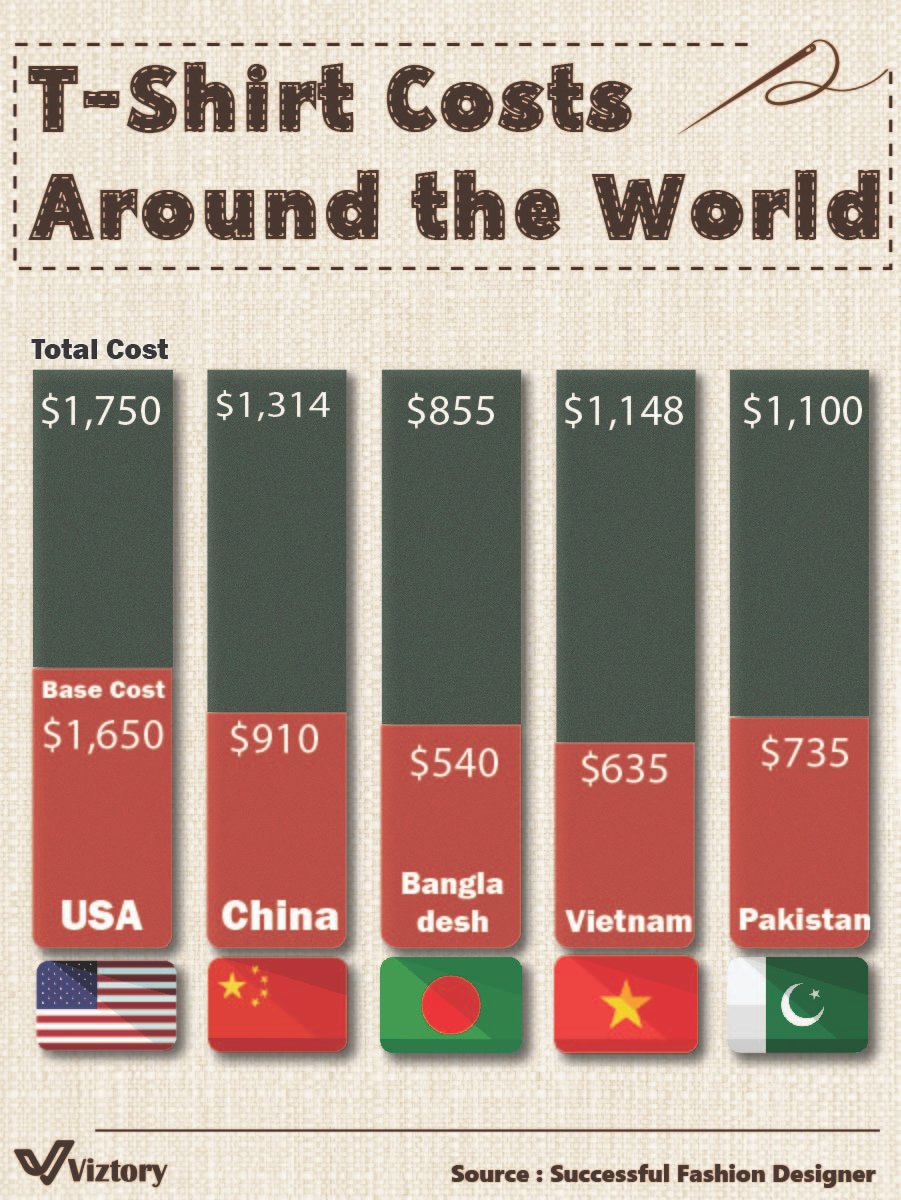T-Shirt Costs Around the World
Introduction
Fashion is a universal language, but its cost structure varies dramatically by geography. The image above, sourced from “Successful Fashion Designer” and visualized by Viztory, compares total and base costs of producing a T-shirt in five major manufacturing countries: USA, China, Bangladesh, Vietnam, and Pakistan.
This snapshot isn’t just about cotton and labor—it’s a lesson in global economics, labor markets, and MONEY. It exposes how fashion intersects with national income levels, business expenses, and value chains.
Comparative Breakdown of Costs
Here are the total and base costs of producing a single T-shirt:
| Country | Base Cost | Total Cost |
|---|---|---|
| 🇺🇸 USA | $1,650 | $1,750 |
| 🇨🇳 China | $910 | $1,314 |
| 🇧🇩 Bangladesh | $540 | $855 |
| 🇻🇳 Vietnam | $635 | $1,148 |
| 🇵🇰 Pakistan | $735 | $1,100 |
Base cost refers to manufacturing expenses (labor, fabric, etc.), while total cost includes transportation, compliance, tariffs, and overhead.
Behind the Seams: What Drives the Price?
1. Labor Costs
-
USA has the highest labor costs, reflecting minimum wage laws and employment benefits.
-
Bangladesh and Pakistan benefit from low-wage skilled labor, leading to the lowest base prices.
2. Operational Overheads
-
Electricity, water, facility maintenance, and taxes vary. The U.S. bears high utility and regulatory costs.
-
Southeast Asia remains cost-efficient due to leaner factory operations.
3. Compliance and Ethical Standards
-
Western countries must adhere to stricter environmental and ethical standards—this drives up costs.
-
Cheaper regions often have less regulation, though this is changing under pressure from global watchdogs.
4. Shipping & Duties
-
Distance from major consumption markets (like the U.S. and EU) can add significantly to total costs.
MONEY Angle: Why the Cost Gap Matters
In global marketing and retail, understanding these cost disparities is essential:
-
Profit Margins: Brands like H&M or Zara rely on cheaper production in Bangladesh or Vietnam to maximize margins.
-
Price Positioning: A $5 T-shirt sold in New York may only cost $0.85 to produce in Dhaka.
-
Brand Ethics: Consumers are increasingly choosing brands that produce ethically—even if they cost more.
Real Example:
A shirt made in the USA for $1.75 might retail for $20, while a similar shirt from Pakistan made for $1.10 may also sell for $20—but the profit margin is substantially different.
Sourcing Strategy and Market Behavior
-
Bangladesh and Vietnam dominate fast fashion exports.
-
China, while more expensive than others in Asia, still holds a dominant position due to its logistics and infrastructure.
-
USA-based production is favored for premium or “Made in America” branding, especially for environmentally conscious consumers.
Brands that understand this balance between cost-efficiency and ethical appeal thrive in today’s market.
Insightful Observations
-
Narrowest margin: Vietnam’s total-to-base cost ratio is the tightest among low-cost producers, implying better logistics and fewer hidden costs.
-
Highest markup: The U.S. sees only a $100 jump from base to total cost—indicating high base expenses dominate.
Conclusion
The cost of a T-shirt tells a global story of labor, logistics, and money flow. It reveals how marketing strategies, production choices, and consumer ethics converge in the simplest of garments.
In an industry where every cent matters, understanding where to source and how to price is as important as the design itself. Whether you’re a fashion entrepreneur or a curious consumer, this cost map offers deep insight into the business of fashion—stitched together with MONEY.

